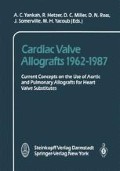Abstract
There is agreement among investigators that the “in vivo reaction” to the implanted allograft is complex and variably related to (1) donor age; (2) procurement and processing methods; (3) implantation position and technique; and (4) immunogenic reaction within the valve cusps (1, 2, 3). Many human and animal experiments have been performed to determine the nature of the donor and host reaction after implantation, and there is disagreement as to whether the transplanted donor cells remain viable. Our findings, as well as O’Brien’s remain opposed to those of Brian Barrett-Boyes and Ross on this issue (4, 5, 6, 7). We believe that donor cells remain viable for extended periods, and that long-term valve function is related to the presence of viable cells in the donor graft (Fig. 1). If viable donor cells are not present, then long-term function is secondary to the basic tissue integrity of the functional valve cusp and not due to repopulation by host cells. It is proven that viable fibroblasts in valve cusps can be detected histologically and by tissue culture after ex-plantation. Our data suggests that these are living donor fibroblasts, and there is limited host invasion into and onto the functional valve cusps after implantation (5, 8, 9). Morphology of both experimental and clinical valve expiants indicate that donor cell hyperplasia and host overgrowth or pannus can be advantageous or deleterious depending upon the location and intensity of collagen deposition (Fig. 2).
Access this chapter
Tax calculation will be finalised at checkout
Purchases are for personal use only
Preview
Unable to display preview. Download preview PDF.
References
Barratt-Boyes BG (1979) Cardiothoracic surgery in the antipodes: including a report of a randomized trial of medical and surgical treatment of asymptomatic patients with severe coronary artery disease; a long-term follow-up of both fresh and antibiotic-treated homograft valves; and some observations on glutaraldehyde-preserved valve tissue. J Thorac Cardiovasc Surg 78 (6): 804–822
Bodnar E, Wain WH, Martelli V, Ross DN (1979) Long-term performance of 580 homograft and autograft valves used for aortic valve replacement. Thorac Cardiovasc Surg 27 (1): 31–38
Buch WS, Kosek JC, Angell WW (1971) The role of rejection and mechanical trauma on valve graft viability. J Thorac Cardiovasc Surg 62: 423
Barratt-Boyes BG, Roche AH, Subramanyan R, Pemberton JR, Whitlock RM (1987) Long-term follow-up of patients with the antibiotic-sterilized aortic homograft valve inserted freehand in the aortic position. Circulation 75 (4): 768–777
Angeli WW, Pillsbury RC, Shumway NE (1969) Storage and function of the canine aortic homo-graft. Arch Surg 99: 92
O’Brien MF, Stafford EG, Gardner MAH, Pohlner PG, McGiffin DC. A comparison of aortic valve replacement with viable cryopreserved and fresh allograft valves with a note on chromosomal studies. J Thorac Cardiovasc Surg, in press
Khanna SK, Ross JK, Monro JL (1981) Homograft aortic valve replacement; seven years’ experience with antibiotic-treated valves. Thorax 36 (5): 330–337
Kosek JC, Iben AB, Shumway NE, Angell WW (1969) Morphology of fresh heart valve homo-grafts. Surg 66: 269
Angeli WW, Buch WS, Shumway NE (1972) The viable aortic homograft. In: Ionescu MI (ed) Biologial tissue in heart valve replacement. London, Butterworth and Co., p 383
Kay PH, Ross DN (1985) Fifteen years’ experience with the aortic homograft: the conduit of choice for right ventricular outflow tract reconstruction. Ann Thorac Surg 40 (4): 360–364
Author information
Authors and Affiliations
Editor information
Editors and Affiliations
Rights and permissions
Copyright information
© 1988 Dr. Dietrich Steinkopff Verlag GmbH & Co. KG, Darmstadt
About this paper
Cite this paper
Angell, W.W., Oury, J.H., Koziol, J.A., Dussault, M.H. (1988). Survival of aortic allografts containing living cells. In: Yankah, A.C., Hetzer, R., Miller, D.C., Ross, D., Somerville, J., Yacoub, M.H. (eds) Cardiac Valve Allografts 1962–1987. Steinkopff. https://doi.org/10.1007/978-3-642-72420-6_41
Download citation
DOI: https://doi.org/10.1007/978-3-642-72420-6_41
Publisher Name: Steinkopff
Print ISBN: 978-3-642-72422-0
Online ISBN: 978-3-642-72420-6
eBook Packages: Springer Book Archive

